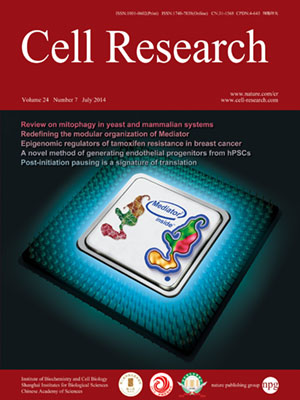
Volume 24, No 7, Jul 2014
ISSN: 1001-0602
EISSN: 1748-7838 2018
impact factor 17.848*
(Clarivate Analytics, 2019)
Volume 24 Issue 7, July 2014: 820-841 | Open Access
ORIGINAL ARTICLES
Manipulation of a VEGF-Notch signaling circuit drives formation of functional vascular endothelial progenitors from human pluripotent stem cells
Makoto Sahara1,2,3,4, Emil M Hansson1,2, Oliver Wernet5, Kathy O Lui1,2,3, Daniela Später1,2,3 and Kenneth R Chien1,2,4
1Department of Stem Cell and Regenerative Biology, 7 Divinity Avenue, Cambridge, MA 02138, USA
2Harvard Stem Cell Institute, Harvard University, 7 Divinity Avenue, Cambridge, MA 02138, USA
3Center for Regenerative Medicine, Massachusetts General Hospital, 185 Cambridge Street, Boston, MA 021141, USA
4Department of Medicine-Cardiology/Cell and Molecular Biology, Karolinska Institutet, SE-171 77 Stockholm, Sweden
5Department of Anesthesiology and Intensive Care Medicine, Charité-University Medicine Berlin, Campus Charité Mitte, Charitéplatz 1, 10117 Berlin, Germany
Correspondence: Makoto Sahara, Tel: +46 8 524 874 79; Fax: +46 8 31 11 01 E-mail: makoto.sahara@ki.se; Kenneth R Chien, Tel: +46 8 524 874 67; Fax: +46 8 31 11 01(kenneth.chien@ki.se)
Human pluripotent stem cell (hPSC)-derived endothelial lineage cells constitutes a promising source for therapeutic revascularization, but progress in this arena has been hampered by a lack of clinically-scalable differentiation protocols and inefficient formation of a functional vessel network integrating with the host circulation upon transplantation. Using a human embryonic stem cell reporter cell line, where green fluorescent protein expression is driven by an endothelial cell-specific VE-cadherin (VEC) promoter, we screened for > 60 bioactive small molecules that would promote endothelial differentiation, and found that administration of BMP4 and a GSK-3β inhibitor in an early phase and treatment with VEGF-A and inhibition of the Notch signaling pathway in a later phase led to efficient differentiation of hPSCs to the endothelial lineage within six days. This sequential approach generated > 50% conversion of hPSCs to endothelial cells (ECs), specifically VEC+CD31+CD34+CD14−KDRhigh endothelial progenitors (EPs) that exhibited higher angiogenic and clonogenic proliferation potential among endothelial lineage cells. Pharmaceutical inhibition or genetical knockdown of Notch signaling, in combination with VEGF-A treatment, resulted in efficient formation of EPs via KDR+ mesodermal precursors and blockade of the conversion of EPs to mature ECs. The generated EPs successfully formed functional capillary vessels in vivo with anastomosis to the host vessels when transplanted into immunocompromised mice. Manipulation of this VEGF-A-Notch signaling circuit in our protocol leads to rapid large-scale production of the hPSC-derived EPs by 12- to 20-fold vs current methods, which may serve as an attractive cell population for regenerative vascularization with superior vessel forming capability compared to mature ECs.
10.1038/cr.2014.59
FULL TEXT | PDF
Browse 2156


